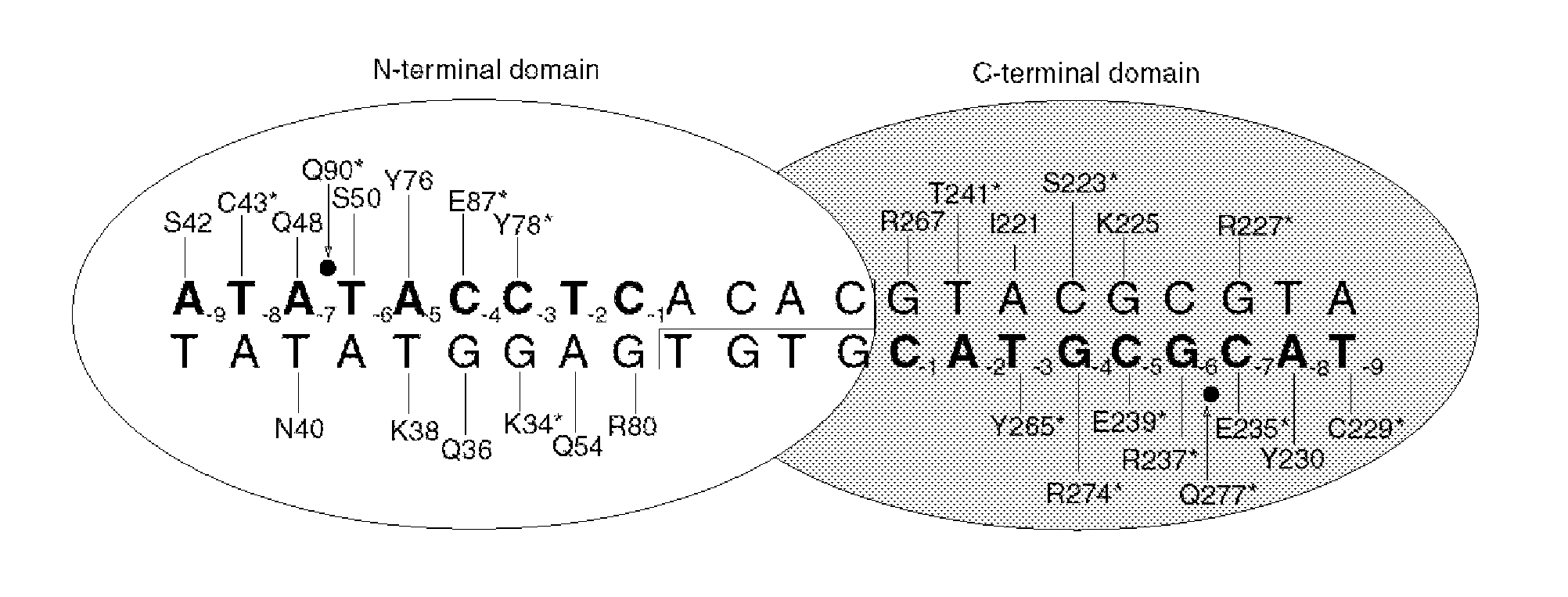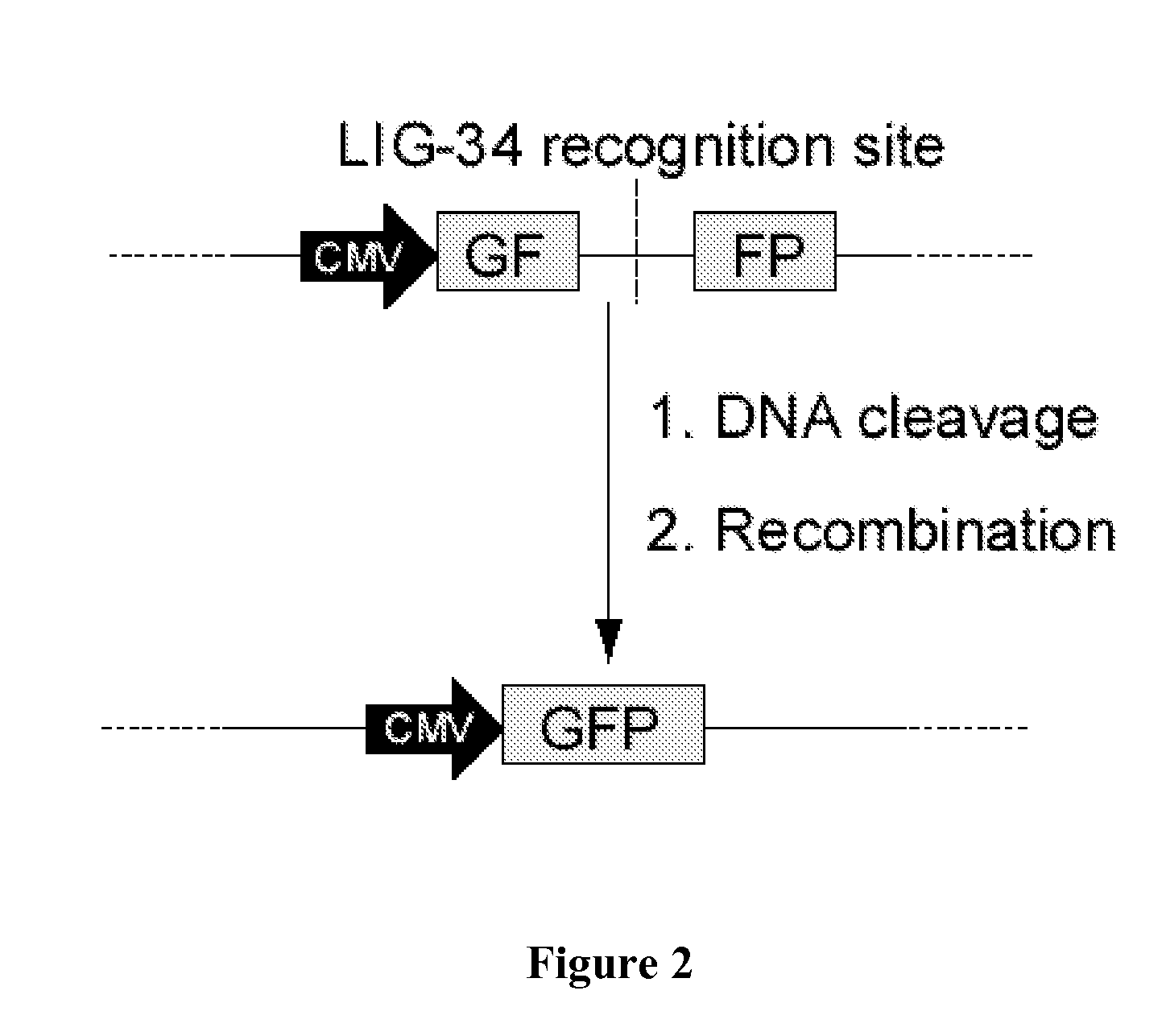Rationally-designed meganucleases for maize genome engineering
a technology of recombinant nucleases and genome engineering, applied in the field of molecular biology and recombinant nucleic acid technology, can solve the problems of residual non-specific cleavage activity, high mutagenic and toxic, and inability to target gene modifications to unique sites within a chromosomal background
- Summary
- Abstract
- Description
- Claims
- Application Information
AI Technical Summary
Benefits of technology
Problems solved by technology
Method used
Image
Examples
example 1
In Vitro DNA Cleavage Activity of the LIG-34 Meganucleases
1. Expression and Purification of LIG-34 meganucleases
[0062]Genes encoding LIG-34, LIG-34+, and LIG-34++ (SEQ ID NO: 1, SEQ ID NO: 12, and SEQ ID NO: 13) were assembled by PCR and cloned into a bacterial expression vector (pET-21a, Novagen Corp., San Diego, Calif.) with a C-terminal 6×-his tag to facilitate purification. The plasmids were then used to transform chemically competent BL21 (DE3) pLysS E. coli, which were plated on standard 2xYT plates containing 200 μg / ml carbanicillin. Following overnight growth, transformed bacterial colonies were scraped from the plates and used to inoculate 50 ml of 2XYT broth. Cells were grown at 37° C. with shaking until they reached an optical density of 0.6-0.8 at a wavelength of 600 nm. The growth temperature was then reduced from 37° C. to 25° C. Protein expression was induced by the addition of 1 mM IPTG, and the cells were incubated with agitation for three hours. Cells were then pel...
example 2
In Vivo DNA Cleavage Activity of the LIG-34 Meganucleases
1. DNA Break / Repair Assay in a Human Cell Line
[0066]LIG-34, LIG-34+, and LIG-34++ were evaluated for DNA cleavage activity in a reporter assay in a human cell-line as follows: a defective GFP reporter cassette was generated by first cloning a 5′ 480 by fragment of the GFP gene into NheI / HindIII-digested pcDNA5 / FRT (Invitrogen Corp., Carlsbad, Calif., USA) resulting in the plasmid, pGF. Next, a 3′ 480 fragment of the GFP gene (including a 240 by sequence duplicated in the 5′ 480 by fragment) was cloned into BamHI / XhoI-digested pGF. The resulting plasmid, pGFFP, consists of the 5′⅔rd of the GFP gene followed by the 3′⅔rd of the GFP gene, interrupted by 24 by of the pcDNA5 / FRT polylinker. To insert the LIG-34 recognition site into pGFFP, complimentary oligonucleotides encoding the binding site were annealed and ligated into HindIII / BamHI-digested pGFFP, resulting in pGFFP.LIG34. This plasmid comprises, in 5′ to 3′ orientation: a ...
PUM
| Property | Measurement | Unit |
|---|---|---|
| Fraction | aaaaa | aaaaa |
Abstract
Description
Claims
Application Information
 Login to View More
Login to View More - R&D
- Intellectual Property
- Life Sciences
- Materials
- Tech Scout
- Unparalleled Data Quality
- Higher Quality Content
- 60% Fewer Hallucinations
Browse by: Latest US Patents, China's latest patents, Technical Efficacy Thesaurus, Application Domain, Technology Topic, Popular Technical Reports.
© 2025 PatSnap. All rights reserved.Legal|Privacy policy|Modern Slavery Act Transparency Statement|Sitemap|About US| Contact US: help@patsnap.com



